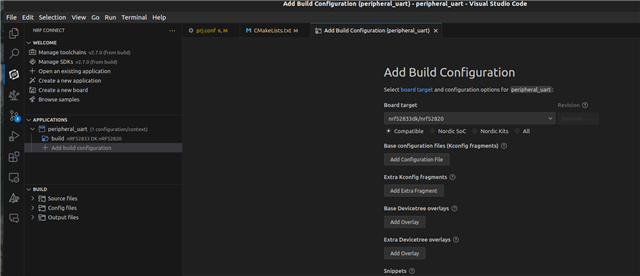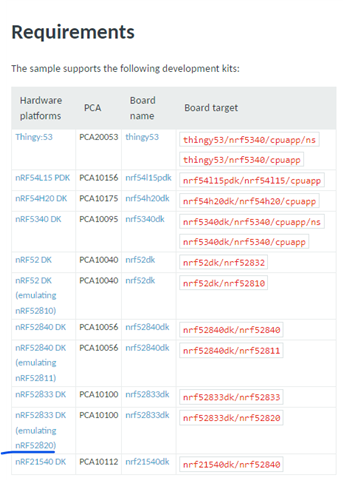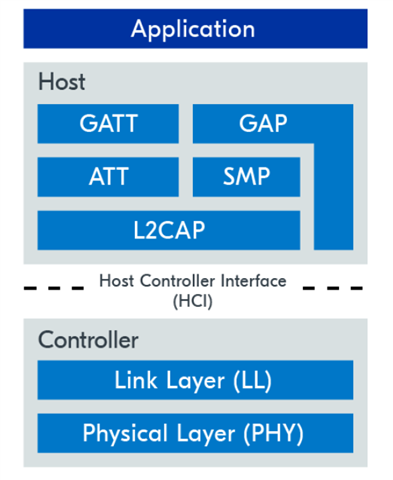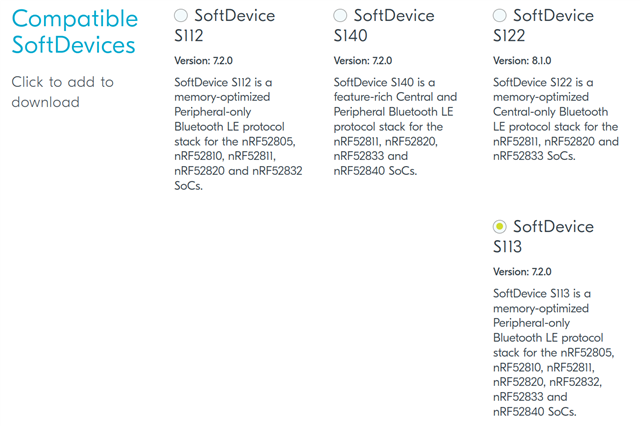Hi guys,
we are planing to use the nRF52820 as BLE proxy to UART/SPI. It shall receive data from a host controller via UART/SPI and forward it via BLE to a smart phone. Also vice versa it will receive data from a smart phone via BLE and forward it via UART/SPI to the host controller. FOTA shall be also a functionality - also some other functionalities shall be added, but nothing too big.
If i understand correctly the sample "Peripheral UART" is perfect for this use case (https://developer.nordicsemi.com/nRF_Connect_SDK/doc-legacy/latest/nrf/samples/bluetooth/peripheral_uart/README.html#configuration). It is available for the nRF52820 so I tried to build it with the build config "nrf52833dk/nrf52820", with SDK and tool chain v2.7.0 and the config:
# # Copyright (c) 2018 Nordic Semiconductor # # SPDX-License-Identifier: LicenseRef-Nordic-5-Clause # # Enable the UART driver CONFIG_UART_ASYNC_API=y CONFIG_NRFX_UARTE0=y CONFIG_SERIAL=y CONFIG_GPIO=y # Make sure printk is printing to the UART console CONFIG_CONSOLE=y CONFIG_UART_CONSOLE=y CONFIG_HEAP_MEM_POOL_SIZE=2048 CONFIG_BT=y CONFIG_BT_PERIPHERAL=y CONFIG_BT_DEVICE_NAME="Nordic_UART_Service" CONFIG_BT_MAX_CONN=1 CONFIG_BT_MAX_PAIRED=1 # Enable the NUS service CONFIG_BT_NUS=y # Enable bonding CONFIG_BT_SETTINGS=y CONFIG_FLASH=y CONFIG_FLASH_PAGE_LAYOUT=y CONFIG_FLASH_MAP=y CONFIG_NVS=y CONFIG_SETTINGS=y # Enable DK LED and Buttons library CONFIG_DK_LIBRARY=y # This example requires more stack CONFIG_MAIN_STACK_SIZE=1152 CONFIG_SYSTEM_WORKQUEUE_STACK_SIZE=2048 # Config logger CONFIG_LOG=y CONFIG_USE_SEGGER_RTT=y CONFIG_LOG_BACKEND_RTT=y CONFIG_LOG_BACKEND_UART=n CONFIG_LOG_PRINTK=n CONFIG_ASSERT=y
but it fails:
/home/art/ncs/toolchains/e9dba88316/opt/zephyr-sdk/arm-zephyr-eabi/bin/../lib/gcc/arm-zephyr-eabi/12.2.0/../../../../arm-zephyr-eabi/bin/ld.bfd: zephyr/zephyr_pre0.elf section `noinit' will not fit in region `RAM'
/home/art/ncs/toolchains/e9dba88316/opt/zephyr-sdk/arm-zephyr-eabi/bin/../lib/gcc/arm-zephyr-eabi/12.2.0/../../../../arm-zephyr-eabi/bin/ld.bfd: region `RAM' overflowed by 3168 bytes
collect2: error: ld returned 1 exit status
ninja: build stopped: subcommand failed.
FATAL ERROR: command exited with status 1: /home/art/ncs/toolchains/e9dba88316/usr/local/bin/cmake --build /home/art/nordic/peripheral_uart/build
If I disable config log with
CONFIG_LOG=n
it builds but has a high RAM usage:
Memory region Used Size Region Size %age Used
FLASH: 180084 B 256 KB 68.70%
RAM: 32288 B 32 KB 98.54%
IDT_LIST: 0 GB 32 KB 0.00%
My question are:
- Is this the correct controller for my use case? If not, which is?
- Is this the correct sample for my use case? If not, which is?
- Why is the sample available for the nrf52820 but does not build out of the box?
- How can I reduce the footprint while still meeting the requirements, especially FOTA, which is increasing footprint heavily (with
CONFIG_BOOTLOADER_MCUBOOT=y
I getregion `FLASH' overflowed by 78632 bytes
)
Thanks in advance!







